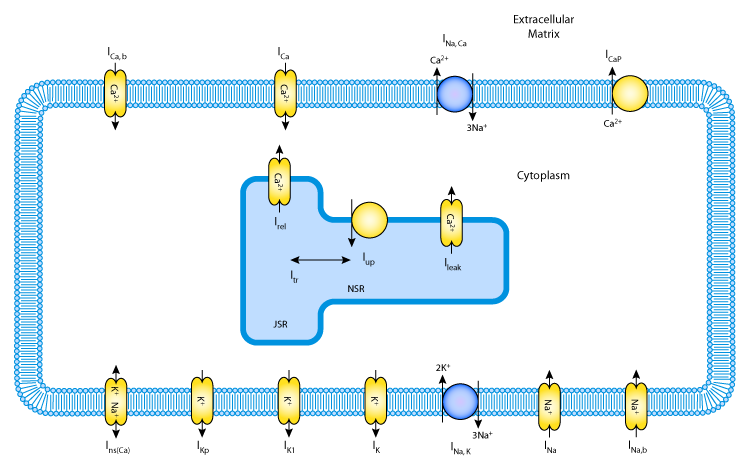Zeng, Laurita, Rosenbaum, Rudy, 1995
Model Status
This model is valid CellML, but does not run in OpenCell or COR because it lacks initial conditions and several parameter values. More importantly, it appears it has been coded to conform with procedural matlab code, and even if the above errors were fixed, other problems would likely persist.
Model Structure
ABSTRACT: Two distinct delayed rectifier K+ currents, IKr and IKs, were found recently in ventricular cells. We formulated these currents theoretically and investigated their roles in action potential repolarization and the restitution of action potential duration (APD). The Luo-Rudy (L-R) model of the ventricular action potential was used in the simulations. The single delayed rectifier K+ current in the model was replaced by IKr and IKs. Our results show that IKs is the major outward current during the plateau repolarization. A specific block of either IKr or IKs can effectively prolong APD to the same degree. Therefore, either channel provides a target for class III antiarrhythmic drugs. In the simulated guinea pig ventricular cell, complete block of IKr does not result in early afterdepolarizations (EADs). In contrast, > 80% block of IKs results in abnormal repolarization and EADs. This behavior reflects the high IKs-to-IKr density ratio (approximately 8:1) in this cell and can be reversed (ie, IKr block can cause EADs) by reducing the ratio of IKs to IKr. The computed APD restitution curve is consistent with the experimental behavior, displaying fast APD variation at short diastolic intervals (DIs) and downward shift at longer DIs with the decrease of basic drive cycle length (BCL). Examining the ionic currents and their underlying kinetic processes, we found that activation of both IKr and IKs is the primary determinant of the APD restitution at shorter DIs, with Ca2+ current through L-type channels (ICa) playing a minor role. The rate of APD change depends on the relative densities of IKr and IKs; it increases when the IKr-to-IKs density ratio is large. The BCL-dependent shift of restitution at longer DIs is primarily attributed to long-lasting changes in [Ca2+]i. This in turn causes different degrees of Ca(2+)-dependent inactivation of ICa and different degrees of Ca(2+)-dependent conductance of IKs at very long DIs (> 5 s) for different BCLs. This BCL dependence of ICa and IKs that is secondary to long-lasting changes in [Ca2+]i is responsible for APD changes at long DIs and can be viewed as a "memory property" of cardiac cells.
The original paper reference is cited below:
Two Components of the Delayed Rectifier K+ Current in Ventricular Myocytes of the Guinea Pig Type, Jinglin Zeng, Kenneth R. Laurita, David S. Rosenbaum and Yoram Rudy, 1995, Circulation Research, 77, 140-152. PubMed ID: 7788872
 |
| A schematic diagram showing of Zeng et al. 1995 ventricular cell model. |

